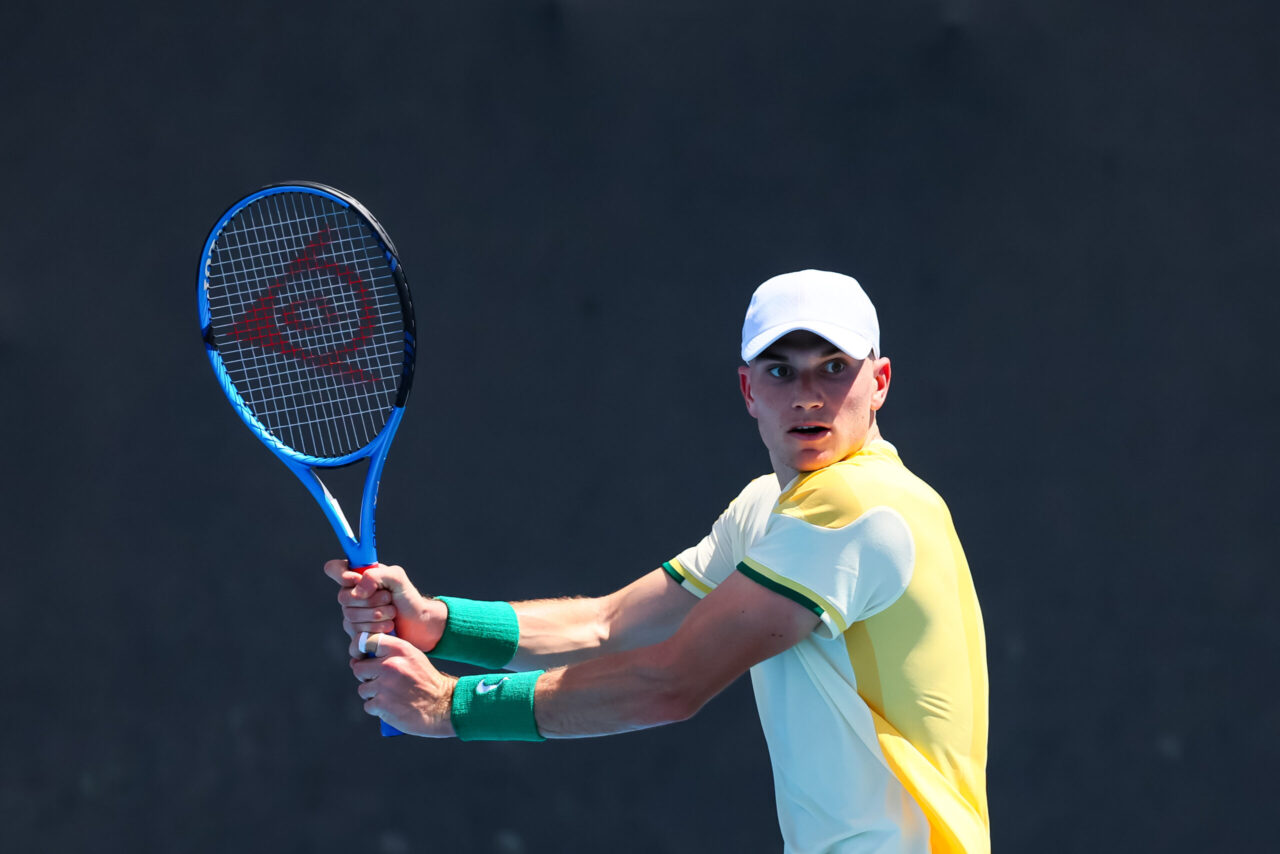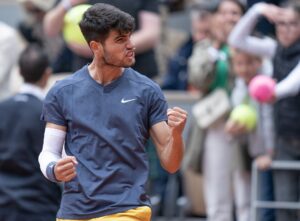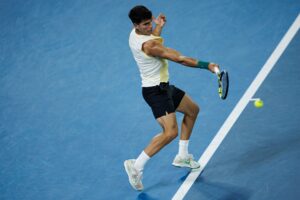The Big Three ruled men’s tennis for so long (over two decades) that by the end of their reign the sport had become a virtual gerontocracy, with Djokovic, Nadal and Federer effectively stymying the Grand Slam ambitions of at least two younger generations of male players. Now that the era of the Big Three is finally coming to an end, the opposite phenomenon can be observed. Men’s tennis is fast becoming a paedocracy or, if that word causes anyone any concern for any reason, a youthocracy, and that was triumphantly proven in Vienna and Basel this weekend, especially by the winners of those tournaments, Jack Draper and Giovanni Mpetshi Perricard.
Draper and Mpetshi Perricard Not Alone In Breaking Through
Draper and Mpetshi Perricard were not alone in breaking through spectacularly over the last week or so of the European indoor circuit. Indeed, probably the most remarkable statistic to emerge from both Vienna and Basel was that of the eight semifinalists in the two tournaments, six were aged 22 or under, including the eventual winners. Only Karen Khachanov and Alex de Minaur, who faced each other in the second semifinal in Vienna, bucked the trend, being a comparatively ancient 28 and 25 respectively.
Of the two tournaments, which always seem to be contested in the same week in late October and therefore are often “twinned” or linked together in the minds of tennis fans, Vienna featured the slightly older and more experienced 22-or-unders. That is because Jack Draper and Lorenzo Musetti, who contested the first semi-final there, are already Grand Slam semifinalists. Musetti reached the last four at Wimbledon this year and Draper almost immediately matched him by making the semifinals at the US Open. Consequently, their rematch in Vienna was an opportunity to compare them directly.
On the evidence of Vienna, Draper’s sheer power, especially on serve, may ultimately make him better equipped to reach more Major semifinals and beyond than Musetti’s sheer artistry, especially on his still-beautiful single-handed backhand. Draper won in straight sets, 6-4 6-2, but what was perhaps most impressive was his ability to survive Musetti’s attempted comeback in the second set. Having won the first set comfortably and then gone up a break early in the second, Draper appeared to be cruising to victory until Musetti began belatedly to produce some of his trademark magic. He broke back to tie the second set at 4-4 but immediately lost his serve again to love, which allowed Draper to serve out for the match.
In the final against Khachanov, Draper had to survive an even more impressive second-set fightback. He had broken early in the first set (the third game, to be precise) to take it 6-4 and then went 4-0 up in the second set as Khachanov’s game, particularly his serve, seemed to collapse completely. Then, however, perhaps because he was affected by nerves at the thought of winning the biggest title of his career to date (an ATP500 event), Draper lost his serve for the first time in the match and Khachanov proceeded to win five games in a row to lead 5-4.
Khachanov must have been dreaming of a comeback victory of his own to match that of Dan Evans against him at the US Open earlier this year, when Evans eventually triumphed in the longest ever match at the tournament. However, Draper successfully stopped the bleeding of points by holding to 5-5, before breaking again and holding serve again to win 7-5. Taken alongside his victory over Musetti, this victory over Khachanov was further evidence of Draper’s rapidly developing mental maturity. When that is finally as powerful as his gigantic physical attributes, notably his punishing left-handed serve, he will be a contender not just for ATP500s but for Masters and even Majors.
Meanwhile in Basel…
Meanwhile in Basel, Giovanni Mpetshi Perricard was winning his own maiden ATP500 event and his own biggest title to date with far greater ease than Draper. Indeed, GMP (as he will surely come to be known for short) proved that among all the new young male contenders and in particular all the new young big servers, which is a list that obviously includes Draper, he might just be the newest and biggest of them all.
Like so many other young players in Vienna and Basel, Mpetshi Perricard has enjoyed a breakout year in 2024, winning his first ATP tournament in Lyon in the run-up to the French Open and then reaching the last 16 at Wimbledon. After a relatively indifferent US Open and Asian swing, he has obviously rediscovered his mojo in Europe’s arenas and was simply spectacular (albeit in a remarkably low-key and undemonstrative way) in winning in Basel.
GMP had begun the week in Switzerland by being “The Canuck-Killer”, i.e. he defeated first Felix Auger-Aliassime and then Denis Shapovalov to reach the semifinals, where he faced a seemingly rejuvenated Holger Rune. But for all Rune’s recent uptick in form and results, he was ultimately powerless against his opponent’s utterly devastating serve. He managed to take the first set to a tie-break, which he lost 8-6, but in the second set a single break was enough to secure victory for the gigantic young Frenchman.
In the Basel final, Mpetshi Perricard faced one of his most serious challengers for the title of “World’s Best Server” in Ben Shelton, who has been regularly clocked at or close to 150 mph. And like Draper and Musetti, Shelton is already a Grand Slam semifinalist, having reached the last four in New York last year. Nevertheless, against Mpetshi Perricard Shelton was effectively out-served, as he regularly had to dive for cover or even use his racket as a shield to try and deflect Mpetshi Perricard’s stream of aces. It is often said of a big server, such as Shelton, that they “serve out of a tree”. Well, if that is true, then GMP is serving out of the treehouse at the top of a very tall tree, because at his best, as it was against Shelton, it is virtually unreturnable.
Of course Mpetshi Perricard is not just a big server but adds to his six foot eight frame a deftness of touch, especially on his single-handed backhand (which is incredibly unusual for a player of his height), that for the moment at least Shelton and many other big servers of his age seem to lack. Consequently, like Draper, Mpetshi Perricard is eminently capable of developing further in 2025 and challenging for Masters, Majors and inclusion in the world’s top 10 within the next 12 months.
Incidentally, it is also worth pointing out that Mpetshi Perricard v Shelton was one of the few ATP finals ever to have been contested by two black players. For a sport that can often struggle to defend itself from accusations of being “too white”, the emergence and success of players like GMP, Shelton and Arthur Fils (who Shelton had beaten in his semi-final) is welcome evidence of the increasing ethnic diversity of men’s tennis.
Who Will Be This Generation’s Third Man? Any One Of Them
Notwithstanding the success of Draper, Mpetshi Perricard and other young players in Vienna and Basel, there is no doubt that the Big Three have been replaced by The New Two of Jannik Sinner and Carlos Alcaraz. Sinner and Alcaraz have already decisively distanced themselves from their peers by winning multiple Majors and reaching the World No.1 spot, a position that Sinner still holds. Consequently, there has been much debate about who will emerge as this generation’s “Third Man” – the equivalent of a Novak Djokovic emerging to take on and even overtake Sinner and Alcaraz, as Djokovic did against Federer and Nadal?
Holger Rune has already put himself forward, largely unconvincingly, for the role and others such as Shelton, Mpetshi Perricard or even last year’s Next Gen winner, Hamad Medjedovic, have also been nominated for it. But the truth is that The Trivalry was not only unprecedented in the history of tennis but in the history of all major professional sport. It is far more likely that, injury (and drugs bans) permitting, Sinner and Alcaraz will remain at the top of the sport but will face a number of outstanding challengers, rather than just one.
That is why the events of Vienna and Basel were so exciting and so promising for the future of men’s tennis, not just in the short term but in the medium and long terms, too. Sinner and Alcaraz may stand apart from the rest for the moment, but as Draper, Mpetshi Perricard, Shelton, Fils, Musetti, Rune and others hopefully develop further they are increasingly likely to challenge them and even beat them, such that we are likely to see a number of new Major winners in the next few years. After the 20-year dominance of the Big Three, the future of men’s tennis is still bright, but for the first time in a long time it is remarkably youthful-looking.
Main photo credit:






